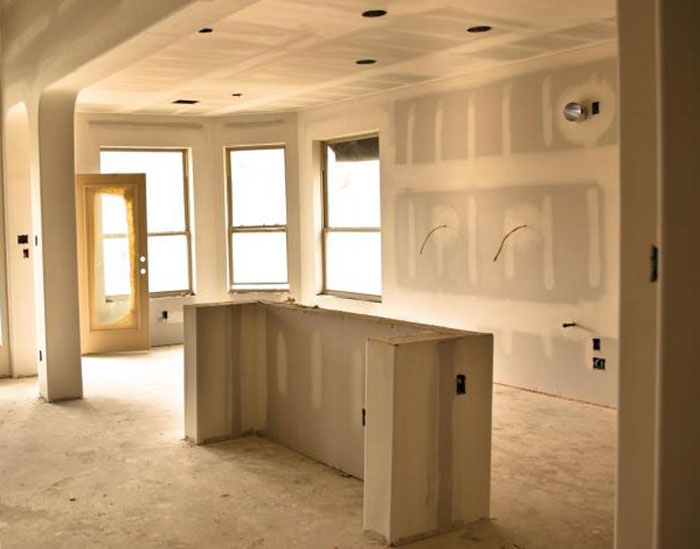Essential Tips for Effective Drywall Repair and Installment Methods
Effective drywall repair service and setup needs a cautious approach. Recognizing the kinds of drywall and having the right tools is vital. Proper methods and accurate measurements can substantially impact the outcome. Lots of neglect crucial steps like taping and fining sand, which can make or break the last appearance. As jobs advance, typical difficulties may arise that require attention. Checking out these tips can cause an extra sleek and successful coating.
Recognizing Various Kinds Of Drywall
Recognizing the different types of drywall is important for any kind of effective repair service or installment job. Drywall, typically called plaster board, can be found in numerous selections tailored for details applications. Standard drywall is one of the most extensively used kind, suitable for basic interior wall surfaces and ceilings. Moisture-resistant drywall, commonly eco-friendly in shade, is created for areas susceptible to humidity, such as kitchen areas and washrooms. Fire-resistant drywall, generally colored pink or purple, is crafted to stand up to higher temperature levels and is commonly made use of in garages or near heaters. In addition, soundproof drywall helps in reducing noise transmission, making it suitable for multi-family homes or recording studios. Specialized drywall, like cement board, is made use of in damp locations like showers or tub borders. Recognizing these kinds helps in picking the right material for each project, making certain toughness and effectiveness in repairs or brand-new installments.
Vital Devices for Drywall Fixing and Installation
Having the right devices is essential for effective drywall repair service and setup. A top quality energy blade is essential for reducing drywall sheets specifically. A drywall T-square aids assure straight edges, while a taping blade is necessary for applying joint substance smoothly over joints. In addition, a drywall saw enables removing damaged sections or fitting drywall around components.
For hanging drywall, a power drill with drywall screws is important, as it enables safe and quick installation. A level is also important to validate that the drywall is straight and properly straightened. Once it has dried, a sanding block or post sander is important for smoothing out joint compound. A gauging tape is crucial for exact measurements, protecting against waste and making certain an appropriate fit. Geared up with these devices, individuals can take on drywall jobs successfully, bring about professional-looking outcomes.
Step-by-Step Guide to Fixing Holes and Cracks
When addressing holes and splits in drywall, having the right tools and products is vital for an effective fixing. This overview describes the necessary items and provides a clear, step-by-step procedure to effectively recover the surface. Recognizing these elements will assist ensure a seamless coating and long-lasting outcomes.
Tools and Materials Needed
A well-equipped toolkit is essential for efficient drywall repair service and setup. Trick devices include an utility blade for reducing drywall, a tape action to assure accurate sizing, and a drywall saw for bigger holes. A putty knife is vital for using joint substance smoothly, while a fining sand block or pole sander assists achieve a seamless coating. For patching, a roll of fiberglass harmonize tape or paper tape is required to reinforce joints. Additionally, a drill and screws are needed for securing brand-new drywall pieces. Vital products contain joint compound, guide, and paint to complete the fixing. Having these devices and products accessible assures a smoother, a lot more reliable repair process, generating professional-looking outcomes.
Fixing Refine Steps
Fixing openings and fractures in drywall needs a methodical approach to assure a seamless coating. Initially, the area bordering the damage should be cleaned extensively to eliminate dust and particles. Next, for small splits, a putty knife is made use of to apply a joint compound uniformly over the area. For larger openings, a spot is required; the damaged area is removed, and a new item of drywall is fitted in place, protected with screws. As soon as the patch remains in setting, joint compound is used to blend the sides. After drying out, sanding the area smooth is essential. The fixed surface area ought to be topped and repainted to match the bordering wall, guaranteeing a low-profile repair work.
Techniques for Putting Up Drywall Panels
Installing drywall panels requires mindful planning and specific execution to assure a smooth and expert coating. It is vital to gauge the wall surface space accurately and cut the panels to fit, making sure that they line up with the studs. Placing the panels horizontally is normally recommended, as this can improve the structural honesty and lower the variety of seams.
Using drywall screws, installers ought to protect the panels every 16 inches along the studs, making certain a company hold. It is vital to stay clear of overdriving the screws, which can harm the paper surface. For sides and edges, utilizing an utility blade permits for tidy cuts and a snug fit.

Completing Touches: Insulation, Mudding, and Sanding
When the drywall panels are securely in place, the following essential step entails the complements of taping, mudding, and sanding. Taping is necessary for creating a seamless change in between panels and concealing joints. A quality drywall tape, either paper or fiberglass harmonize, need to be used over the seams, guaranteeing it adheres correctly to the mud that will be used following.
Mudding, or applying joint substance, complies with the taping procedure. This compound fills up gaps and smooths out the surface area. A first coat must be applied generously, feathering the edges to blend with the drywall. After the preliminary coat dries, succeeding layers may be required for a perfect coating.
Fining sand is required to attain a smooth surface. A fine-grit sandpaper should be utilized to carefully ravel any type of imperfections. Care must be required to stay clear of over-sanding, which can harm the drywall - drywall contractors. Effectively performed, these ending up touches develop an look at this web-site expert appearance ready for painting
Tips for Preserving Your Drywall After Installment
Maintaining drywall after installation is vital to protecting its appearance and architectural stability. Routine cleansing is necessary; dust and dirt can accumulate, so mild cleaning with a moist fabric is suggested. Home owners need to also evaluate for any indicators of wetness or mold and mildew, particularly in high-humidity locations like kitchen areas and restrooms. If any damages takes place, it's vital to address it without delay to avoid more problems.
Using furniture pads can assist avoid scratches or dents from heavy items. Additionally, painting the drywall with a high-grade, washable paint supplies an extra layer of security and makes future cleaning easier. Stay clear of utilizing rough cleaners or devices, as these can harm the surface area. Finally, maintaining a stable indoor environment with suitable humidity levels will certainly assist stop fracturing or buckling gradually. By following these pointers, one can assure that drywall stays in exceptional problem for several years to come.
Regularly Asked Inquiries
For How Long Does Drywall Require To Fully Dry After Setup?

Can I Install Drywall Over Existing Drywall?
Yes, drywall can be installed over existing drywall, yet it is important to assure the underlying surface area is secure and properly prepared. This method can improve insulation and reduce setup time, though it might add weight.
What Is the very best Method to Soundproof Drywall?
The very best method to soundproof drywall involves utilizing specialized soundproofing materials, such as durable channels, acoustic caulk, and sound-dampening drywall. These techniques effectively minimize audio transmission between spaces, improving overall acoustic performance in living rooms.
Just how Do I Select the Right Drywall Density?
To choose the best drywall thickness, consider the application and location. Standard household wall surfaces generally utilize 1/2 inch, while ceilings or specialized areas may need 5/8 inch for additional strength and soundproofing capabilities.
Are There Eco-Friendly Drywall Options Available?
Yes, green drywall options are available. These consist of products this content made from recycled products, gypsum boards with low volatile organic substances (VOCs), and those using lasting production procedures, supplying environmentally-conscious selections for building and restoration jobs.
Having the right tools is vital for reliable drywall fixing and installation. For hanging drywall, a power drill with drywall screws is vital, as it allows fast and safe and secure setup. Trick tools include an utility blade for cutting drywall, a tape step to ensure exact sizing, and a drywall saw for larger holes. Yes, drywall can be mounted over existing drywall, however helpful resources it is necessary to guarantee the underlying surface is protected and effectively prepared. The finest method to soundproof drywall includes making use of specialized soundproofing products, such as durable channels, acoustic caulk, and sound-dampening drywall.